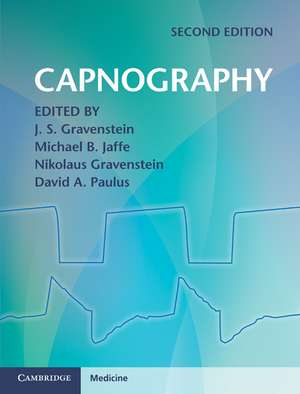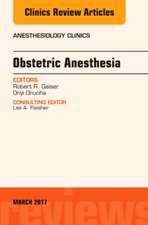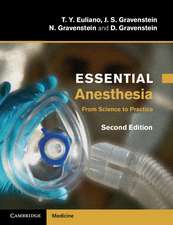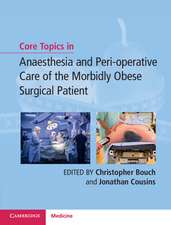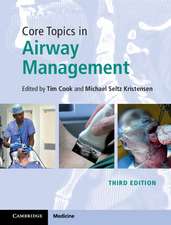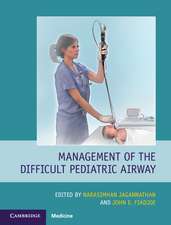Capnography
Editat de J. S. Gravenstein, Michael B. Jaffe, Nikolaus Gravenstein, David A. Paulusen Limba Engleză Hardback – 16 mar 2011
Preț: 1375.27 lei
Preț vechi: 1447.66 lei
-5% Nou
Puncte Express: 2063
Preț estimativ în valută:
263.22€ • 271.27$ • 222.23£
263.22€ • 271.27$ • 222.23£
Carte tipărită la comandă
Livrare economică 03-17 martie
Preluare comenzi: 021 569.72.76
Specificații
ISBN-13: 9780521514781
ISBN-10: 0521514789
Pagini: 488
Ilustrații: 260 b/w illus.
Dimensiuni: 193 x 253 x 27 mm
Greutate: 1.18 kg
Ediția:2 Rev ed.
Editura: Cambridge University Press
Colecția Cambridge University Press
Locul publicării:Cambridge, United Kingdom
ISBN-10: 0521514789
Pagini: 488
Ilustrații: 260 b/w illus.
Dimensiuni: 193 x 253 x 27 mm
Greutate: 1.18 kg
Ediția:2 Rev ed.
Editura: Cambridge University Press
Colecția Cambridge University Press
Locul publicării:Cambridge, United Kingdom
Cuprins
Preface; 1. Clinical perspectives J. S. Gravenstein; Part I. Ventilation: 2. Capnography and respiratory assessment outside of the operating room Robert R. Kirby; 3. Airway management in the out-of-hospital setting Christian C. Zuver, George A. Ralls, Salvatore Silvestri and Jay L. Falk; 4. Capnography: airway management in the hospital setting Ajeet G. Vinayak and Jonathan D. Truwit; 5. Airway management on the operating room David G. Bjoraker; 6. Capnography during anesthesia Yong G. Peng, David A. Paulus and J. S. Gravenstein; 7. Monitoring during mechanical ventilation John Thompson and Nancy Craig; 8. Capnography during transport of patients (inter/intra-hospital) Michael Frakes; 9. Capnography as a guide to ventilation in the field Daniel Davis; 10. Neonatal monitoring Gerd Schmalisch; 11. Capnography in sleep medicine Patrick Troy and Geoff Gilmartin; 12. Conscious sedation Edwin A. Bowe and E. F. Klein, Jr; 13. Capnometry monitoring in high and low pressure environments Carl W. Peters, Gregory H. Adkisson, Mehmet S. Ozcan and Thomas J. Gallagher; 14. Biofeedback Alicia E. Meuret; 15. Capnography in noninvasive positive pressure ventilation (NPPV) Joseph A. Orr, Michael B. Jaffe and Adam Seiver; 16. End-tidal carbon dioxide monitoring in postoperative ventilator weaning Joseph Varon and Paul E. Marik; 17. Optimizing the use of mechanical ventilation and minimizing its requirement with capnography Ira M. Cheifetz and Donna Hamel; 18. Volumetric capnography for monitoring lung recruitment and PEEP titration Gerardo Tusman, Stephan H. Böhm and Fernando Suarez-Sipmann; 19. Capnography and adjuncts of mechanical ventilation Umberto Lucangelo, Francesca Bernabe and Lluis Blanch; Part II. Circulation, Metabolism and Organ Effects: 20. Cardiopulmonary resuscitation David C. Cone, Justin C. Cahill and Marvin A. Wayne; 21. Capnography and pulmonary embolism John T. Anderson; 22. Noninvasive cardiac output via pulmonary blood flow Ron Dueck; 23. PaCO2, PETCO2, and gradient John B. Downs; 24. The physiologic basis for capnometric monitoring in shock Kevin R. Ward; 25. Carbon dioxide production, metabolism and anesthesia Dafna Willner and Charles Weissman; 26. Tissue- and organ-specific effects of carbon dioxide Ozan Akça; Part III. Special Environments/Populations: 27. Atmospheric monitoring outside the healthcare environment and within enclosed environments: a historical perspective Gregory H. Adkisson and David A. Paulus; 28. Capnography in veterinary medicine Richard M. Bednarski and William Muir; Part IV. Physiologic Perspectives: 29. Carbon dioxide pathophysiology Timothy E. Morey; 30. Acid base balance and diagnosis of disorders Philip G. Boysen and Amy Isenberg; 31. Ventilation/perfusion abnormalities and capnography Nawar Al Rawas, Andrea Gabrielli and A. Joseph Layon; 32. Capnographic measures Umberto Lucangelo, Antonino Gullo, Francesca Bernabe and Lluis Blanch; 33. Improving the analysis of volumetric capnograms Gerardo Tusman, Adriana Gabriella Scandurra, Emilio Maldonado and Lucia Isabel Passoni; 34. Capnography and the SPM applied to cardiac output recovery and airway structure and function Peter W. Scherer, John W. Huang and Kai Zhao; 35. Carbon dioxide and the control of breathing: a quantitative approach Michael C. K. Khoo; Part V. Technical Perspectives: 36. Technical specifications and standards Daniel E. Supkis; 37. Carbon dioxide measurement Michael B. Jaffe; 38. Gas flow measurement Michael B. Jaffe; 39. Combining flow and carbon dioxide Joseph Orr and Michael B. Jaffe; Part VI. Historical Perspectives: 40. Brief history of time and volumetric capnography Michael B. Jaffe; 41. The first years of clinical capnography Bob Smalhout; 42. The early days of volumetric capnography Roger Fletcher; Appendix. Patterns of time-based capnograms; Index.
Recenzii
Review of the first edition: '… addresses the physiologic and technological considerations that need to be understood to make capnography a clinically useful tool and should be standard reading for those who depend on it as an anesthetic monitor.' Anesthesiology Journal
Review of the first edition: '… a good addition to the reference library of departments of anesthesiology, critical care and emergency medicine.' Canadian Journal of Anesthesiology
'The inclusion of informative chapters on neonatal monitoring, sleep medicine, sedation, and veterinary medicine usefully widens the appeal of the book … [It] should be seen as an essential specialist reference book for the departmental library that those interested and/or needing to gain knowledge in capnography … can dip in and out of when required.' British Journal of Anaesthesia
Review of the first edition: '… a good addition to the reference library of departments of anesthesiology, critical care and emergency medicine.' Canadian Journal of Anesthesiology
'The inclusion of informative chapters on neonatal monitoring, sleep medicine, sedation, and veterinary medicine usefully widens the appeal of the book … [It] should be seen as an essential specialist reference book for the departmental library that those interested and/or needing to gain knowledge in capnography … can dip in and out of when required.' British Journal of Anaesthesia
Descriere
Reviews the technical aspects and clinical application of capnographs to diagnose a range of medical disorders.
